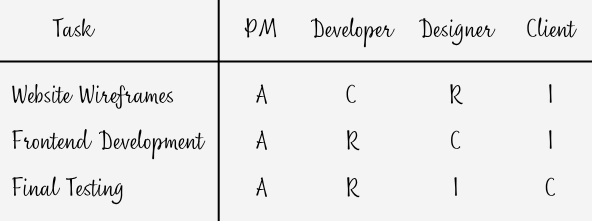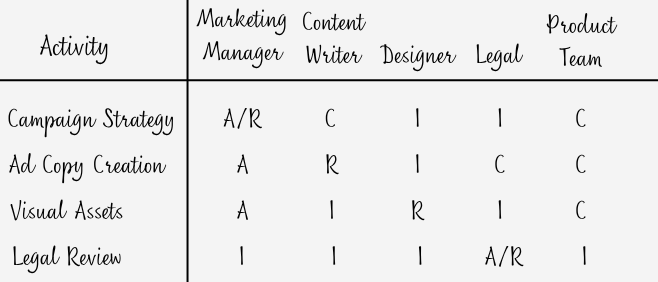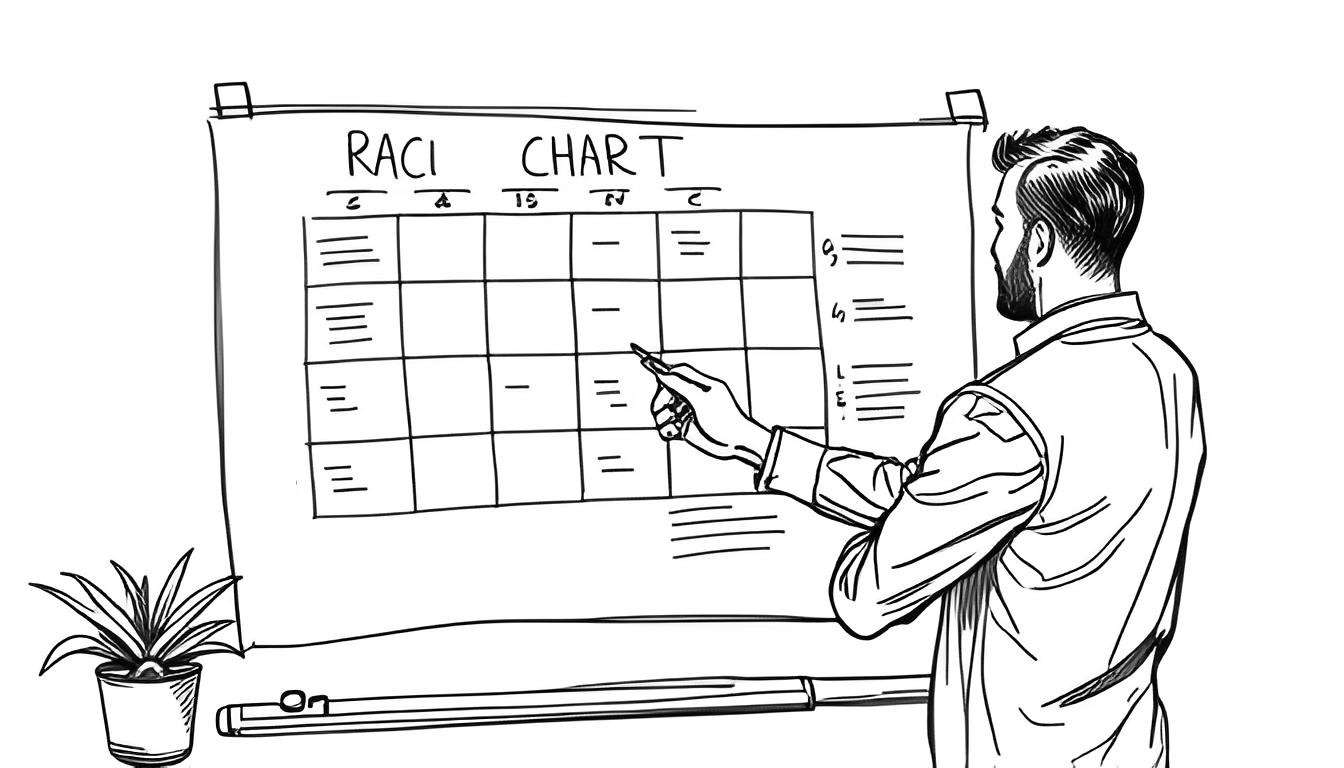In many projects, confusion often arises because it’s not clear who’s responsible for what. A RACI chart helps solve this by clearly defining each person’s role, so everyone knows what to expect and who’s in charge of each part.
Key Topics
- Understanding the four RACI roles: Responsible, Accountable, Consulted, and Informed
- Step-by-step process for creating effective RACI matrices that actually work
- Real-world examples showing how RACI charts transform project management
- Common pitfalls that trip up teams and how to steer clear of them
- Practical implementation tips for rolling out RACI in your organization
RACI charts from scratch
It’s common to see project meetings where there’s uncertainty about who should lead a specific task. Sometimes no one takes ownership, and other times too many people get involved, causing confusion and overlap.
This kind of role confusion doesn’t just slow down projects; it burns out team members and creates tension that can tear apart even the best teams. That’s where the RACI chart comes in – it’s like having a clear roadmap that shows everyone exactly where they fit in the project puzzle.
This article will walk you through everything you need to know about RACI charts, from the basics to advanced implementation strategies. By the time you’re done reading, you’ll have the tools to set up crystal-clear accountability in any project you’re running.
What Is a RACI Chart?
A RACI chart is a responsibility assignment matrix that breaks down who plays what role for each task in your project. Think of it as your project’s organizational chart, but instead of showing reporting relationships, it shows exactly how people contribute to getting work done.
The magic is in the four letters that make up RACI:
R – Responsible

This is the person who rolls up their sleeves and actually does the work. They’re the ones getting their hands dirty, putting in the hours, and making things happen. In most cases, you’ll have one person who’s responsible for each task, though sometimes a small team might share this role.
A – Accountable

The accountable person is the one who signs off on the work and takes ownership of the final outcome. They’re not necessarily doing the work themselves, but they’re the ones who’ll answer for it if things go sideways. Here’s a key rule: there should only be one accountable person per task – no exceptions.
C – Consulted

These are your subject matter experts (SME) and stakeholders who need to weigh in before decisions get made. They provide input, share expertise, and help shape the approach. The important thing is that communication flows both ways – you’re not just telling them what’s happening, you’re actively seeking their input.
I – Informed

The informed folks need to stay in the loop about what’s happening, but they don’t have a direct say in how things get done. They’re usually downstream stakeholders who’ll be affected by the work or need to know about progress for their own planning.
The beauty of this framework is that it forces you to think through every aspect of task ownership. No more assuming someone else will pick up the ball – everything’s spelled out clearly.
Why Use a RACI Chart?
RACI charts are a valuable tool for project organization because they address common issues that teams face on a daily basis.
Eliminates Task Duplication
There are projects where three different people start working on the same deliverable because nobody knows who’s supposed to handle it. Talk about wasted effort! A RACI chart nips this in the bud by clearly assigning ownership upfront.
Clarifies Decision-Making Authority
When push comes to shove and tough decisions need to be made, you don’t want a committee trying to figure out who gets the final say. The RACI matrix makes it obvious who has the authority to make the call and move things forward.
Improves Communication Flow
Instead of playing email tag trying to figure out who needs to be looped in, your RACI chart shows exactly who should be consulted and who just needs a heads-up. This cuts down on meeting overload and ensures the right people get the right information at the right time.
Boosts Team Efficiency
When everyone knows their role and stays in their lane, work flows smoothly. People can focus on their piece of the puzzle without constantly checking in or stepping on each other’s toes. The result? Projects that actually finish on time and on budget.
Reduces Conflict and Friction
Most team conflicts stem from unclear expectations about who’s supposed to do what. When roles are crystal clear from the start, there’s less room for the kind of misunderstandings that lead to heated discussions and hurt feelings.
How to Create a RACI Chart
Building an effective RACI chart isn’t rocket science, but there is a method to the madness. Here’s a step-by-step approach to guide teams through the process:
Step 1: Break Down Your Project Tasks
Start by listing out all the major activities and deliverables in your project. Don’t get too granular – you’re looking for chunks of work that make sense to assign to specific people. Think of these as your project’s building blocks.
Step 2: Identify All the Players
Make a list of everyone who’ll touch the project in any way. This includes team members, stakeholders, sponsors, and anyone else who might need to weigh in or stay informed. Cast a wide net here – it’s better to include someone who doesn’t need to be involved than to leave out someone who does.
Step 3: Map Out the Relationships
This is where the rubber meets the road. For each task, go through your list of people and assign them one of the four RACI roles. Remember the golden rule: only one person can be accountable for each task.
Step 4: Review and Validate
Don’t just create your RACI chart in a vacuum. Get the team together and walk through it line by line. Ask questions like: “Does this make sense to everyone?” and “Are we missing anyone?” This collaborative review catches issues before they become problems.

Real-Life Example: Marketing Campaign Launch
Here’s an example of how RACI charts work in practice and why they’re so valuable: in a project involving the launch of a digital marketing campaign for a SaaS product, clearly defining roles helped the team stay organized and efficient.
The Setup
A cross-functional team including marketing, design, content, legal, and product teams can quickly run into problems without clear roles. Projects like this risk becoming a free-for-all where everyone ends up stepping on each other’s toes.
RACI Breakdown

What Made This Work
The RACI chart keeps everyone focused on their specific contributions. The content writer is responsible for the copy but needs input from legal and product teams. The designer can focus on visuals without getting pulled into strategy discussions. Most importantly, the project manager remains accountable for overall execution while delegating the actual work to the right specialists.
Using a RACI chart can help projects launch on time, stay under budget, and avoid the usual last-minute scrambling that happens when roles aren’t clear.
Common Mistakes to Avoid
Teams often stumble with RACI charts in predictable ways. Here are some common mistakes that can cause problems if not addressed:
Multiple Accountable People Per Task
This is the big one. When you have two people who are both accountable for the same deliverable, you actually have nobody who’s accountable. It’s like that old saying about too many cooks in the kitchen – except worse, because now nobody wants to take ownership when things go wrong.
Creating the RACI Chart in Isolation
Don’t lock yourself in a room and come up with the perfect RACI chart on your own. The people who’ll be living with these assignments need to have a say in how they’re structured. When people help create the framework, they’re much more likely to stick to it.
Setting It and Forgetting It
Projects evolve, and your RACI chart needs to evolve with them. When scope changes or people join or leave the team, you need to update your responsibility matrix. An outdated RACI chart is almost worse than having no chart at all.
Getting Too Granular
Some teams go overboard and try to RACI every tiny task. This creates more confusion than clarity. Focus on significant activities and deliverables – the stuff that actually matters for project success.
Not Explaining the Difference Between R and A
This trips up more teams than you’d think. People often assume that being responsible means being accountable, but they’re different roles. Make sure everyone understands that responsible people do the work, while accountable people own the outcome.
Tips for Implementing RACI in Your Team
Rolling out RACI charts isn’t just about creating a pretty matrix – you need to make sure your team actually uses it. Here’s what I’ve learned about successful implementation:
Start Small and Build Momentum
Don’t try to RACI your entire organization overnight. Pick one project or team and get them comfortable with the process. Once they see the benefits, word will spread naturally and other teams will start asking for help setting up their own charts.
Use Collaborative Tools
Keep your RACI chart somewhere everyone can access and reference easily. Google Sheets is great for simple projects and tools like Asana or Monday.com are better for more complex initiatives. The key is making sure it’s always up-to-date and easy to find.
Review Regularly in Team Meetings
Don’t just create your RACI chart and hope people remember it. Bring it up in your regular team meetings, especially when you’re discussing upcoming tasks or dealing with confusion about who should handle something.
Make It Visual
A well-designed RACI chart should be easy to scan and understand at a glance. Use color coding, clear formatting, and logical organization. If people have to squint to figure out what they’re looking at, they won’t use it.
Train Your Team on the Concepts
Don’t assume everyone knows what RACI means or how to apply it. Spend time upfront explaining the framework and walking through examples. This investment pays off when people start using the tool correctly from day one.
Lead by Example
As the project manager, you need to be the first person to reference the RACI chart when questions come up. When someone asks “Who’s handling the user testing?” you should be able to point to the chart and say “According to our RACI, Sarah’s responsible and I’m accountable.”
RACI vs. Other Responsibility Matrices
RACI isn’t the only game in town when it comes to responsibility assignment. Let’s break down some alternatives and when you might want to use them instead:
RASCI (Adding “Support”)
This variation adds an “S” for Support – people who provide resources or assistance to the responsible party. You can use RASCI when you have complex projects where the person doing the work needs significant backup from others.
DACI (Driver, Approver, Contributors, Informed)
DACI focuses more on decision-making than task execution. The “Driver” moves things forward, while the “Approver” has final authority. This works well for strategic initiatives where decisions matter more than tasks.
RACIO (Adding “Out of Loop”)
Sometimes it’s useful to explicitly identify who doesn’t need to be involved. The “O” for “Out of Loop” helps prevent scope creep and keeps unnecessary stakeholders from getting pulled into the work.
When to Stick with RACI
For most project management scenarios, classic RACI hits the sweet spot. It’s simple enough that people actually use it, but comprehensive enough to handle the complexity of most initiatives. Only reach for alternatives when you have specific needs that RACI doesn’t address.
Recap
RACI charts are one of those simple tools that deliver outsized results. They cut through the confusion that bogs down so many projects and give everyone a clear understanding of their role.
The beauty of RACI is that it forces you to think through responsibility assignment upfront, when it’s easy to make changes, rather than scrambling to figure things out when deadlines are looming. It’s like having a GPS for your project – everyone knows where they’re going and how they fit into the bigger picture.
Don’t overthink it. Start with a simple project, create your first RACI chart, and see how it changes the way your team operates. Once you experience the clarity and efficiency that comes from well-defined roles, you’ll wonder how you ever managed projects without this framework.
The next time you’re kicking off a project and someone asks “Who’s supposed to handle this?” you’ll have a clear answer. That’s the power of RACI – turning confusion into clarity, one responsibility at a time.

